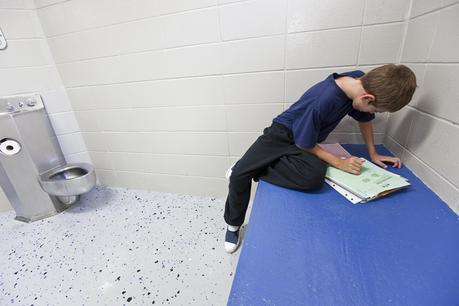 This article was originally published at Manifesta Magazine.
This article was originally published at Manifesta Magazine.On March 25, Harvard Law School hosted Juvenile in Justice, an exhibit which documents how youth are treated by the US justice system. I was unable to attend the entire event, but what I heard was extremely powerful. I have never really thought about how the justice system treats young people, so this event taught me how desperately it needs to be transformed into an effective, fair system that helps rather than hurts the youth that go through it.
I found UCSB Professor of Photography Richard Ross’ discussion of his work documenting how youth are treated by prisons and their authority members extremely powerful. He talked about the ways he’s seen children and teens treated in prisons, and showed photographs or videos to back up his most surprising points. For example, he projected two photos of nearly identical jail cells on the screen; the only major difference was that one had a window and one did not. The one with the window was a cell in Guantanamo Bay. The one without was a solitary confinement cell at a youth prison in Texas. I was absolutely shocked. How can the American justice system give accused terrorists better accommodations than its own youth?
Honestly, it was a little terrifying to hear how young people are treated in jails, and how the so-called “justice” system is not very good at living up to its name. “[The system is] not great on rehabilitation but good at retribution, we get our pound of flesh from kids…[who] don’t have the voice to fight back,” Ross said. After hearing some of the stories he shared about the young people he’s photographed, I can only agree with Ross’ conclusions. The example of the fifth grader who got into a fistfight at school and was sent to prison for the day because his mother, an undocumented immigrant who could not leave work for fear of losing her job to pick him up, really resonated with me. It just shows how systemic this issue really is.
Ross discussed how girls in the prison system have all experienced abuse and drugs before they enter the prison system – “no exceptions” – but nobody gives them additional attention to help them rehabilitate themselves. I thought it was interesting when he said that a change in language is helping how the system treats these girls; for example, he mentioned how girls who used to be called “teen prostitutes” are now being referred to as “child victims of sex trafficking.” It made me happy to hear that the system is slowly changing to be more sensitive to the issues at hand.
I really respect Ross for spending his time doing this work, a necessary but thankless task. “[It] is such a calling to me,” he said. He does not do it for personal gain – he does not charge money for his photos – but because “I want the next generation to understand what’s at stake by giving images to people.” He wants to use his “art as a weapon” by providing images to activists who can reform the youth prison system based off of the photographs he takes. People like Ross, who check their privilege and use it to help those without power or a voice, truly inspire me to take further action. To show your support for his cause and help spread the word, you can like his Facebook page and share the work on his website. With activists like him in the world, I am confident that it will soon become a better place.
To see more photos Richard Ross has taken, visit his website.

